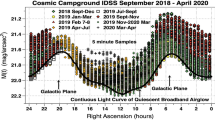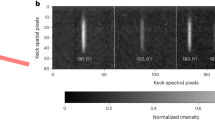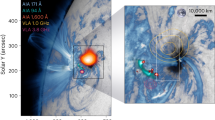Abstract
DIFFICULTIES are certainly associated with the preparation of observational auroral frequency-lines. In general, some of the most important ones are supposed to be those due to too low density of the observational net, individual variations among the observers with regard to observational scheme and definitions, variations of the sensitivity of observational method, etc. Correction for variation of the solar activity over the observational periods for the different observers must be introduced. In addition to this, adjustments for cloud and daylight must be made, as mentioned by Dr. Stagg.
Similar content being viewed by others
Article PDF
Author information
Authors and Affiliations
Rights and permissions
About this article
Cite this article
HULTQVIST, B. Auroral Frequency Lines. Nature 184, 263 (1959). https://doi.org/10.1038/184263a0
Issue Date:
DOI: https://doi.org/10.1038/184263a0
Comments
By submitting a comment you agree to abide by our Terms and Community Guidelines. If you find something abusive or that does not comply with our terms or guidelines please flag it as inappropriate.



